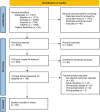Implementation of child-centred outcome measures in routine paediatric healthcare practice: a systematic review
- PMID: 37394520
- PMCID: PMC10316621
- DOI: 10.1186/s12955-023-02143-9
Implementation of child-centred outcome measures in routine paediatric healthcare practice: a systematic review
Abstract
Background: Person-centred outcome measures (PCOMs) are commonly used in routine adult healthcare to measure and improve outcomes, but less attention has been paid to PCOMs in children's services. The aim of this systematic review is to identify and synthesise existing evidence of the determinants, strategies, and mechanisms that influence the implementation of PCOMs into paediatric healthcare practice.
Methods: The review was conducted and reported in accordance with PRISMA guidelines. Databased searched included CINAHL, Embase, Medline, and PsycInfo. Google scholar was also searched for grey literature on 25th March 2022. Studies were included if the setting was a children's healthcare service, investigating the implementation or use of an outcome measure or screening tool in healthcare practice, and reported outcomes relating to use of a measure. Data were tabulated and thematically analysed through deductive coding to the constructs of the adapted-Consolidated Framework for Implementation Research (CFIR). Results were presented as a narrative synthesis, and a logic model developed.
Results: We retained 69 studies, conducted across primary (n = 14), secondary (n = 13), tertiary (n = 37), and community (n = 8) healthcare settings, including both child self-report (n = 46) and parent-proxy (n = 47) measures. The most frequently reported barriers to measure implementation included staff lack of knowledge about how the measure may improve care and outcomes; the complexity of using and implementing the measure; and a lack of resources to support implementation and its continued use including funding and staff. The most frequently reported facilitators of implementation and continued use include educating and training staff and families on: how to implement and use the measure; the advantages of using PCOMs over current practice; and the benefit their use has on patient care and outcomes. The resulting logic model presents the mechanisms through which strategies can reduce the barriers to implementation and support the use of PCOMs in practice.
Conclusions: These findings can be used to support the development of context-specific implementation plans through a combination of existing strategies. This will enable the implementation of PCOMs into routine paediatric healthcare practice to empower settings to better identify and improve child-centred outcomes.
Trial registration: Prospero CRD 42022330013.
Keywords: Child health services; Implementation science; Paediatrics; Patient reported outcome measures; Systematic review.
© 2023. The Author(s).
Conflict of interest statement
The authors declare that they have no competing interests.
Figures
References
-
- World Health Organisation . People-Centred Health Care: A Policy Framework. Geneva: Switzerland; 2007.
-
- Namisango E, Bristowe K, Murtagh FE, Downing J, Powell RA, Abas M, et al. Towards person-centred quality care for children with life-limiting and life-threatening illness: Self-reported symptoms, concerns and priority outcomes from a multi-country qualitative study. Palliat Med. 2020;34(3):319–335. doi: 10.1177/0269216319900137. - DOI - PubMed
Publication types
MeSH terms
LinkOut - more resources
Full Text Sources
Medical



